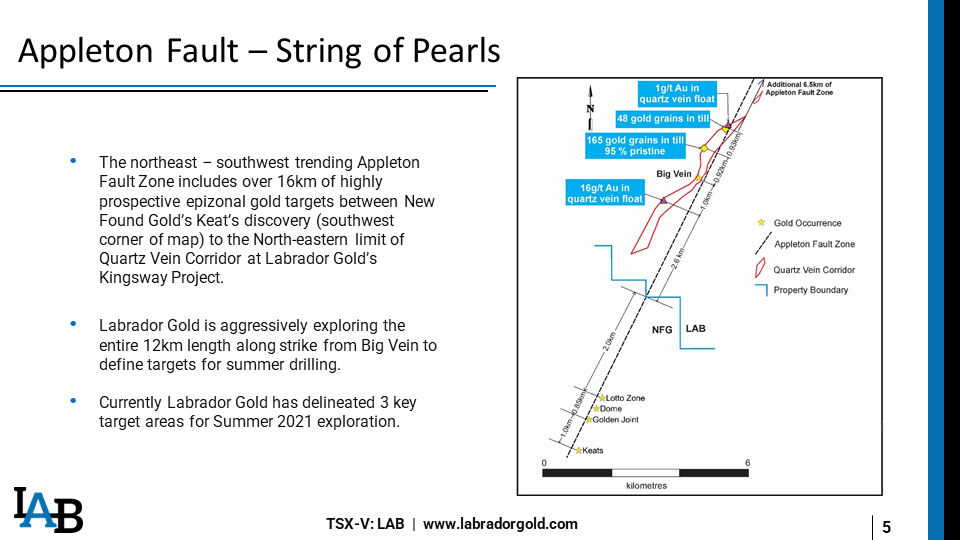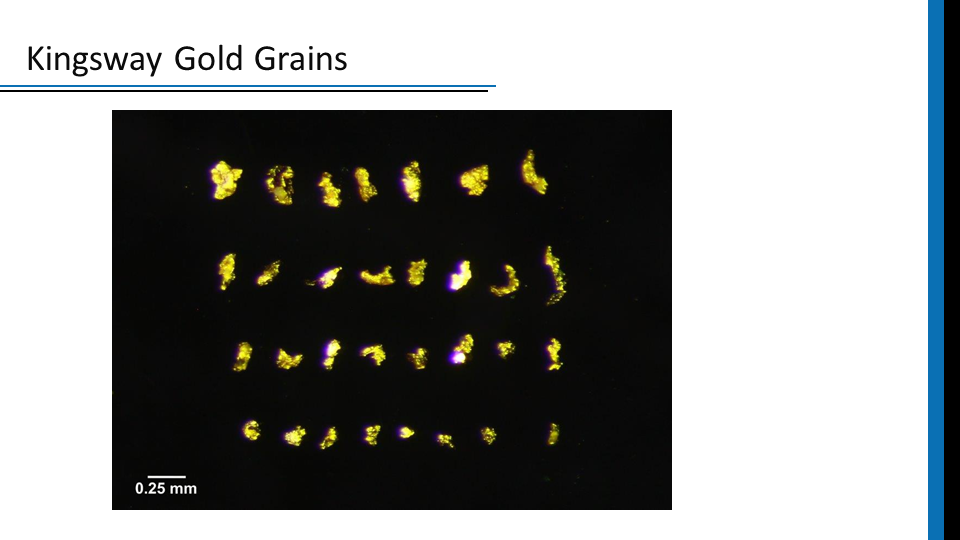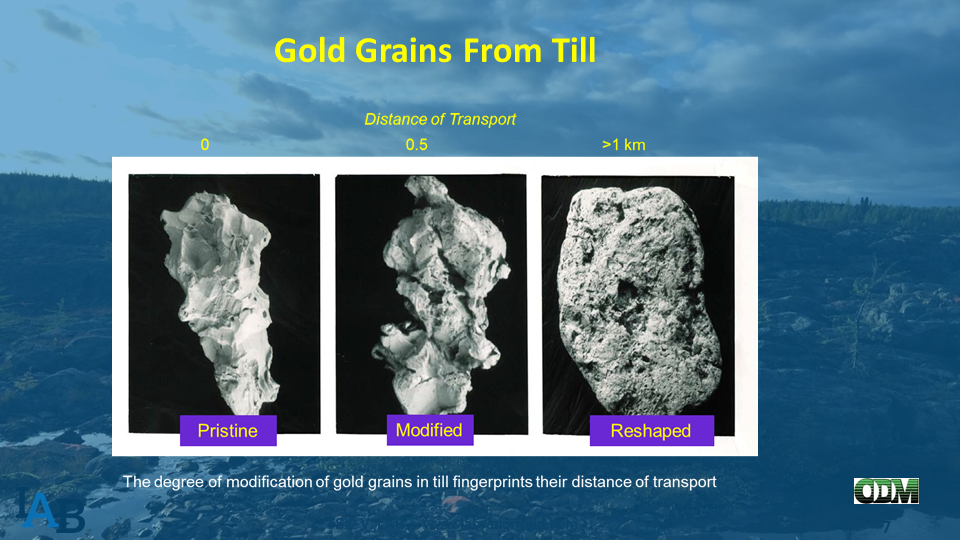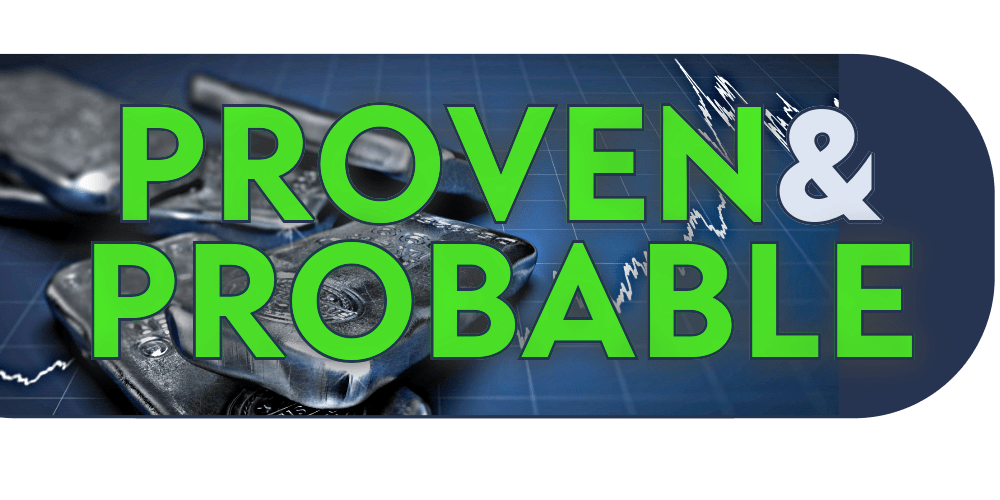Maurice Jackson:
Joining us for a conversation is Roger Moss, the CEO of Labrador Gold (TSX.V: LAB | OTCQX: INOKF). It’s a pleasure to be speaking with you sir, as you have some very encouraging news coming from the Kingsway Gold Project, this time in the form of pristine gold grains. Before we begin, Dr. Moss, who is Labrador Gold, and what is the opportunity the company presents to shareholders?

Dr. Roger Moss:
Labrador Gold is a junior mining company based in Canada, and we’re currently exploring in Newfoundland on our flagship Kingsway Gold Project. We’ve done quite a bit of work on there over the last year, and this Spring we embarked on a 50,000-meter drill program. We made a discovery late last year of visible gold in quartz grain boulders. And we’ve been drilling for a few months with some nice high-grade hits. We are quite excited about the potential before us, and our recent press releases seem to indicate that we may be onto something. And today’s news adds even more to the story.

Maurice Jackson:
Dr. Moss take us to the Kingsway Gold Project, which is along a structure highway known for gold-bearing fluids, please acquaint us with the primary structures.

Dr. Roger Moss:
One of the things that interested me about Kingsway when I first heard about it and we moved to acquire it, was the fact that we had these major crustal structures running through it. And we know that the kinds of gold deposits that we’re looking at here, orogenic and epigenetic gold deposits, they are associated with these major crustal structures. If you have them, it’s great, you can find gold along them. And we are fortunate enough to have two, the Appleton Fault Zone and Dog Bay Line. Most of our work to date has been along the Appleton Fault Zone, and it’s almost a no brainer because down to the south of us where New Found Gold are exploring, they’ve been having incredible success exploring along the Appleton Fault Zone with their great intersections at Keats and Lotto, and most recently at the Golden Joint, so they have three occurrences down there along the Appleton Fault Zone, and ours is just starting, and our Big Vein target is also located along the Appleton Fault Zone. It seems to be a pretty prospective structure that’s running through the property.
Maurice Jackson:
Speaking of the Big Vein in the Appleton Fault Zone, at the conclusion of our last interview, you stated that, “the Big Vein may be the first of many occurrences and that the ideal situation is finding a string of pearls along the Appleton Fault Zone.” Let’s see if the ideal has the potential to come to fruition. Let’s visit the Appleton Fault Zone as earlier today, Labrador Gold announced till results of pristine gold grains. Dr. Moss, what can you share with us?

Dr. Roger Moss:
Labrador recently conducted a pretty big till sampling survey over the lowermost, southernmost two licenses of the Kingsway Project. And I think there was 57 till samples in total, and we got some nice results and the key here, and I think you said it twice, I’m going to say it again, is pristine. Pristine gold grains and that means that these grains haven’t traveled very far from their source, and that’s what we see here in these results.

Dr. Roger Moss:
If I may just digress a little bit so that I can explain why these pristine grains are so important. We’re looking at rocks and grains that have been dumped out of glaciers as they melt and recede, so when the glaciers move across the rock, they scrape and scour the bedrock and they entrain all the material that they’re scouring and they carry it with them, and when they recede and melt, they start dropping that material all the way back to the source, so the more pristine the gold grains are, the closer to the source they would have been because you can’t transport these very flaky gold grains very far without completely modifying their shape.

Dr. Roger Moss:
And so, in terms of gold grain morphology for till sampling, we talk about pristine, closest to the source. Modified, further away, maybe around half a kilometer or more, and then reshaped where the gold grains are totally bent onto themselves and more rounded, and that’s furthest away from the source and probably up to over a kilometer away from the source. So, the pristine grains that we have, they indicate that those grains are very close to the source of mineralization that they came from.
Maurice Jackson:
Identifying the source, mode of transportation, along with pristine gold is a huge success. Does today’s release bode well on the ideal of having a string of pearls along the Appleton Fault Zone?

Dr. Roger Moss:
Oh, absolutely! To give you an example, and this is where it gets really exciting because we had a till sample that was taken right next to Big Vein, and it had something like 165 grains of gold in total and something like 80% of them were pristine. That’s great. So, it hadn’t come very far from the source, but we know that Big Vein has visible gold in there. We found a big boulder last year of quartz vein with visible gold in it, so it’s not a big jump to say that, “Well yeah, sure. That till sample came from Big Vein.” It seems to be a reasonable idea, but the results that we announced today, there are two samples, another one with 165 grains of gold, somewhere just over 90% of them pristine, very close to the source and the other one, 311 grains of gold, just over 80% pristine.
Dr. Roger Moss:
311 grains of gold is almost double the number of grains of gold that we found in the sample next to Big Vein and that occurs 700 to 800 meters northeast of Big Vein, so that means that the gold grains in those samples did not come from Big Vein. They came from somewhere much closer to the sample locations, so this goes back to my pearls on a string story, and we’re just adding pearls to the string with these till samples. It’s very exciting. It means that Big Vein is likely not the only occurrence that we’re going to be drilling, and there’s definitely more to be found along this Appleton Fault Zone.

Maurice Jackson:
Speaking of extending the string, Labrador Gold has embarked on a 50,000-meter drill program this spring. What work is currently being conducted on-site, and do you have any updates on when we may expect more assays?

Dr. Roger Moss:
Oh, that’s what everybody asks, of course. You got to ask it at some point and the answer is always the same. The labs are backed up, we’re getting results, but they’re much slower, and it seems like as every week goes by the turnaround time gets longer. One of our guys was at the lab yesterday and he came back, and he said, “Roger, you won’t believe the number of samples that are in that lab waiting to be assayed.” He said, “There are bags and bags and bags, just waiting to be assayed.”
Dr. Roger Moss:
I said, “Man, you should have taken a photograph, and that could be my answer when I get asked that question. ‘Look, folks this is what it’s like, the labs are jampacked”. We are getting results in, we will be putting out more results from the drilling. It’s going well, and yeah, I know patience is not the biggest trait of some investors, but you know what? I think that we’re going to be there. When these results come in, it’s going to be good, and I think we’ve got a long way to go yet, so yeah, I think patience is definitely required here.
Maurice Jackson:
Leaving the Kingsway Gold Project, let’s get into some numbers. Sir, please provide the capital structure for Labrador Gold.

Dr. Roger Moss:
Right now, we have around 150 million shares outstanding, and probably another 50 million warrants and options, so just over 200 million are fully diluted. We have 35 million in the bank. We don’t have any debt. So yeah, I think we’re in a pretty good position to keep on with this exploration that we’re doing and to keep going.
Maurice Jackson:
In closing, Dr. Moss, what would you like to convey to shareholders?
Dr. Roger Moss:
Well, earlier in the season when we were drilling, and it can be frustrating sometimes when we’re not hitting as often as we would like or we don’t see the results that we would like, but of course not every hole is going to hit, but I just tell myself, “Don’t stop believing,” and that’s the name of the game here. You have to believe as a geologist in this industry, you got to believe that you’re going to find the deposit that you’re looking for. And I think all indications right now are that we’re on the right track, and it’s a matter of time before we see something significant.
Maurice Jackson:
Dr. Moss for readers that wants to get more information about Labrador Gold, please share the contact details.
Dr. Roger Moss:
Yeah, you can email info@labradorgold.com, www.labradorgold.com is our web address. And I would recommend people look at our Twitter feed @LabGoldCorp. We post a lot of information on Twitter. YouTube is another channel, our YouTube channel, lots of videos there, so there’s a lot of information out there besides what’s on the website, but yeah, Twitter and YouTube both are channels that we use fairly extensively.
Maurice Jackson:
Dr. Moss, it’s been a pleasure speaking with you. Wishing you and Labrador Gold the absolute best, sir.
And as a reminder, I am a licensed representative to buy and sell precious metals through Miles Franklin Precious Metals Investments, where we have several options to expand your precious metals portfolio, from physical delivery of gold, silver, platinum, palladium, and rhodium, to offshore depositories, and precious metals IRA’s. Give me a call at 855.505.1900 or you may email: Maurice@MilesFranklin.com. Finally, please subscribe to www.provenandprobable.com, where we provide: Mining Insights and Bullion Sales, subscription is free.
